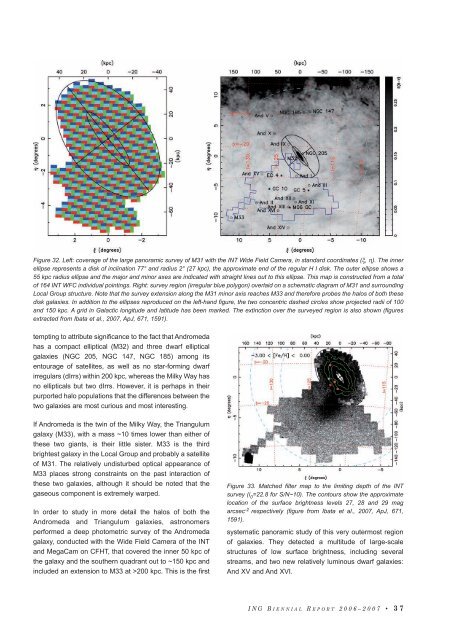PDF (6M) - Isaac Newton Group of Telescopes - Instituto de ...
PDF (6M) - Isaac Newton Group of Telescopes - Instituto de ...
PDF (6M) - Isaac Newton Group of Telescopes - Instituto de ...
You also want an ePaper? Increase the reach of your titles
YUMPU automatically turns print PDFs into web optimized ePapers that Google loves.
Figure 32. Left: coverage <strong>of</strong> the large panoramic survey <strong>of</strong> M31 with the INT Wi<strong>de</strong> Field Camera, in standard coordinates (ξ, η). The inner<br />
ellipse represents a disk <strong>of</strong> inclination 77° and radius 2° (27 kpc), the approximate end <strong>of</strong> the regular H I disk. The outer ellipse shows a<br />
55 kpc radius ellipse and the major and minor axes are indicated with straight lines out to this ellipse. This map is constructed from a total<br />
<strong>of</strong> 164 INT WFC individual pointings. Right: survey region (irregular blue polygon) overlaid on a schematic diagram <strong>of</strong> M31 and surrounding<br />
Local <strong>Group</strong> structure. Note that the survey extension along the M31 minor axis reaches M33 and therefore probes the halos <strong>of</strong> both these<br />
disk galaxies. In addition to the ellipses reproduced on the left-hand figure, the two concentric dashed circles show projected radii <strong>of</strong> 100<br />
and 150 kpc. A grid in Galactic longitu<strong>de</strong> and latitu<strong>de</strong> has been marked. The extinction over the surveyed region is also shown (figures<br />
extracted from Ibata et al., 2007, ApJ, 671, 1591).<br />
tempting to attribute significance to the fact that Andromeda<br />
has a compact elliptical (M32) and three dwarf elliptical<br />
galaxies (NGC 205, NGC 147, NGC 185) among its<br />
entourage <strong>of</strong> satellites, as well as no star-forming dwarf<br />
irregulars (dIrrs) within 200 kpc, whereas the Milky Way has<br />
no ellipticals but two dIrrs. However, it is perhaps in their<br />
purported halo populations that the differences between the<br />
two galaxies are most curious and most interesting.<br />
If Andromeda is the twin <strong>of</strong> the Milky Way, the Triangulum<br />
galaxy (M33), with a mass ~10 times lower than either <strong>of</strong><br />
these two giants, is their little sister. M33 is the third<br />
brightest galaxy in the Local <strong>Group</strong> and probably a satellite<br />
<strong>of</strong> M31. The relatively undisturbed optical appearance <strong>of</strong><br />
M33 places strong constraints on the past interaction <strong>of</strong><br />
these two galaxies, although it should be noted that the<br />
gaseous component is extremely warped.<br />
In or<strong>de</strong>r to study in more <strong>de</strong>tail the halos <strong>of</strong> both the<br />
Andromeda and Triangulum galaxies, astronomers<br />
performed a <strong>de</strong>ep photometric survey <strong>of</strong> the Andromeda<br />
galaxy, conducted with the Wi<strong>de</strong> Field Camera <strong>of</strong> the INT<br />
and MegaCam on CFHT, that covered the inner 50 kpc <strong>of</strong><br />
the galaxy and the southern quadrant out to ~150 kpc and<br />
inclu<strong>de</strong>d an extension to M33 at >200 kpc. This is the first<br />
Figure 33. Matched filter map to the limiting <strong>de</strong>pth <strong>of</strong> the INT<br />
survey (i 0 =22.8 for S/N~10). The contours show the approximate<br />
location <strong>of</strong> the surface brightness levels 27, 28 and 29 mag<br />
arcsec -2 respectively (figure from Ibata et al., 2007, ApJ, 671,<br />
1591).<br />
systematic panoramic study <strong>of</strong> this very outermost region<br />
<strong>of</strong> galaxies. They <strong>de</strong>tected a multitu<strong>de</strong> <strong>of</strong> large-scale<br />
structures <strong>of</strong> low surface brightness, including several<br />
streams, and two new relatively luminous dwarf galaxies:<br />
And XV and And XVI.<br />
ING BIENNIAL R EPORT 2006–2007 • 37
















